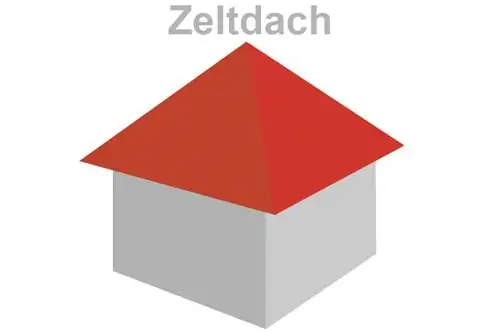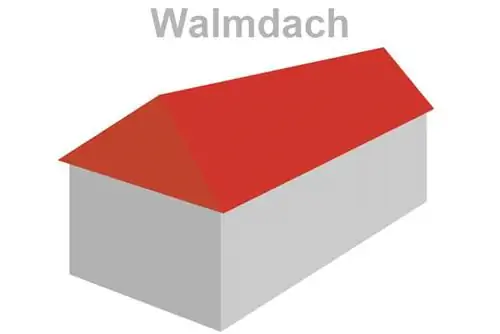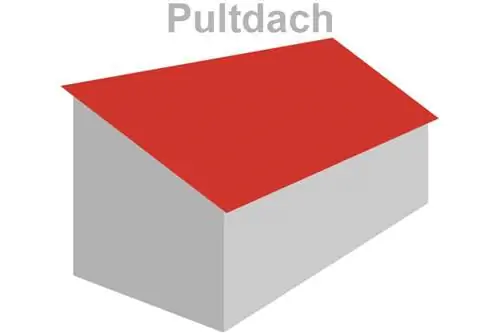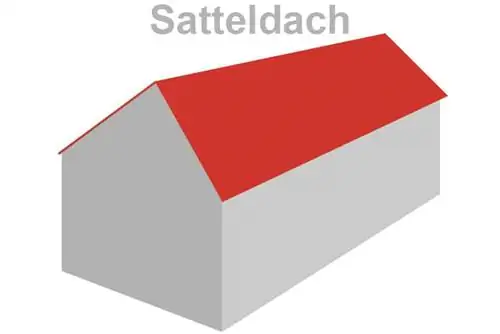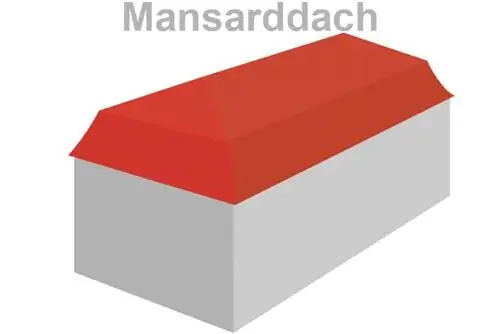- Author admin [email protected].
- Public 2023-12-17 03:39.
- Last modified 2025-06-01 06:48.
There is no mistaking where the tent roof gets its name from. But this roof shape has long since made it into the circle of design stylistic devices in residential building construction. A few fundamental advantages make it stand out from other roof shapes. We explain these differences and also provide numerous interesting facts about the tent roof.
Form and origin
Of course, based on the name alone, the relationship between the tent roof and the real tent is unmistakable. But the design is also visually reminiscent of the simplest form of the tent consisting of a central pole with a tarpaulin stretched over it. The first permanent dwellings in the form of yurts, simple huts and other forms also rely on this simple and effective roof shape.
Adapted to the usually orthogonally oriented residential house floor plans, a tent roof usually consists of four roof surfaces with identical inclinations that touch each other at a central ridge point. This results in the almost inevitable square shape of a building covered with this roof. A surrounding lower roof edge reinforces the impression of a self-contained roof hood sitting on the building structure. A popular nickname for residential buildings with a tent roof is, for example, “mushroom house”.
The static structure
From the shape with a central ridge point it quickly becomes apparent that the tent roof, despite its visual proximity, has to follow a completely different approach than the gable roof:
1. Central ridge support
- Vertical transfer of loads from the ridge point into the solid components underneath (ceiling or wall)
- From every corner of the building from hip rafters to the ridge point as the upper support or connection point for the rafters
- Circumferential threshold as lower support point
- Rafters as load-bearing elements of the roof structure of the individual roof areas
2. Purlin construction
- All-round threshold as the lower support point for the rafters
- All-round purlin as an upper support, usually about a third to a quarter of the rafter length from the ridge point
- Upper rafter ends freely cantilevered to the ridge point
- Purlins supported on foundation components via supports or walls
3. Rigid frame construction
- All-round threshold as the lower support point of the roof structure
- Rib rafters from the corners of the building to the ridge point, supporting each other, as a rigid frame structure without middle support
- Roof rafters placed on hip rafters, or tied in the same level
Typical roof structures for tent roofs
Constructively, possible roof systems for the tent roof are based on the proven methodology:
- Inside: Vapor diffusion-tight level to prevent moisture from entering the living space into the insulation level
- Insulation layer
- Diffusion-open sub-roof for ventilating moisture escaping from the roof structure, if necessary in combination with another insulation layer
- Rear ventilation level to remove escaping water vapor
- Exterior: Roof skin with substructure
Ultimately, both common options can be found in the tent roof to realize this structure in relation to the supporting structure:
1. In-roof insulation
The insulation level corresponds to the rafter level. For this purpose, the insulation is inserted as a soft insulating material between the rafters. The respective limiting layers are provided below and above the rafter layer. The visually visible inner end of the roof structure is formed by a cladding made of wood or painted, plastered or wallpapered plasterboard.
2. Roof insulation
The insulation layer is built up on the structural rafter layer and can be created either as soft insulation between bearing timbers, or as a continuous, pressure-resistant insulation layer. As a basis for the insulation layer, a flat covering made of various wood materials must be built on the rafters. With this variant, the supporting structure remains visible in the roof space and can be visually staged.
NOTE:
Unlike many other roof shapes, on-roof insulation is very common with tent roofs. The background is the high number of structural elements and detail points in the rafter position, which would lead to a large number of points of disruption to the insulation layer if installed at the construction level.
The roof pitch
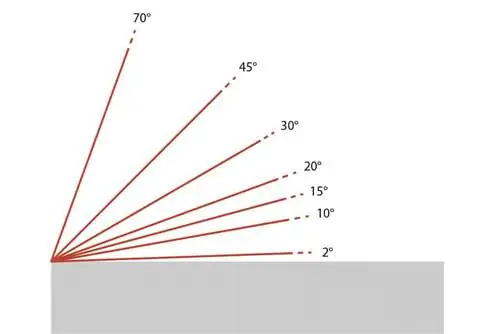
Ultimately, a tent roof can be erected with all angles from 0 degrees. However, the construction only becomes technically sensible from around 10 to 15 degrees, as the roof space gained is otherwise predominantly used by structural components. Inclinations between 15 and around 30 degrees are common today. Larger inclinations of 45 degrees and more, on the other hand, create a voluminous roof space, which, however, is very difficult to use due to the inclination on all sides. In these cases, an alternative, more usable roof shape is usually chosen.
Roof coverings
A tent roof can be provided with almost any number of different roof coverings depending on the roof pitch. Flat coverings should be preferred over tiles or shingles, especially for small roofs, as otherwise countless adjustments and cutting of individual tiles would be necessary due to the ridge details that can be found on all sides. Types of coverings that are frequently encountered are:
- Bricks and concrete roof tiles - mostly from 15 degrees, some models from 10 degrees
- Foil roofs - any roof pitch
- Gravel or green covering on a foil roof - above 10 degrees only makes limited sense
- Slate, shingles and other local covering variants - usually from around 15 to 20 degrees, depending on the substructure
NOTE:
Since the tent roof in residential buildings has no significant history, there are no typical, historical forms of covering, such as straw, thatch or reed.
Roof structures and installations
Basically, the individual roof surfaces of a tent roof are suitable for the construction or installation of dormers or roof balconies. However, the tent roof is generally used with a rather flat slope. Added to the fact that the roof areas are trimmed on all sides, only very large roofs have enough roof area left to sensibly place these structures. In practice, even roof windows are rarely found on tent roofs.
Distinction from other roof shapes
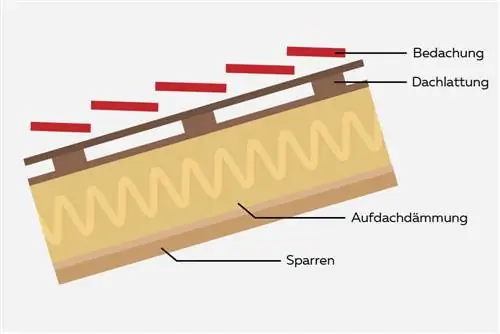
Actually, from a purely geometric point of view, the design of a real tent roof is only possible on square buildings. In practice, it is also generally used in floor plans that are very close to the square. However, since a real square can only be realized very rarely for many reasons, numerous special forms of the tent roof cover the buildings. They are usually very similar to an extremely pronounced hipped roof, in which either the ridge line was minimized to zero with a different inclination of the hipped and main surfaces, or the point ridge of the tent roof was expanded into a short, but still linearly shaped ridge with an identical inclination on all sides. The exact demarcation of the tent roof from other roof shapes is ultimately difficult, but the name is of secondary importance in terms of practical implementation anyway.
Cost of a tent roof
A reliable comparison of the costs of a tent roof against other roof types is hardly possible. The reason is the common use of this roof shape. While independent lounges are often created in gable or hipped roofs, the tent roof often covers a full-fledged standard floor with floor-to-ceiling vertical walls. However, if you take into account the other special features regarding the floor plan requirements for buildings with a tent roof, this roof shape should not appear to be more expensive, at least in relation to other roof shapes on the same building.
Advantages and difficulties
Of course, various aspects of the tent roof also have a positive impact, while other circumstances are rather difficult:
Advantages
- Good roofing for otherwise difficult, square floor plans
- The roof has a low visual weight due to its inclination on all sides - the roof shape appears very light
- Low roof space volume, therefore no need for additional usable space, good solution without unnecessary dead space
Disadvantages
- High constructive effort
- Numerous detail and intersection points
- hardly any roof installations or installations possible

